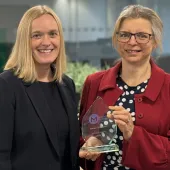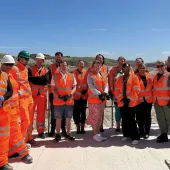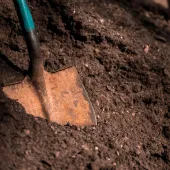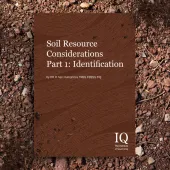Merger between Institute of Quarrying and National Stone Centre
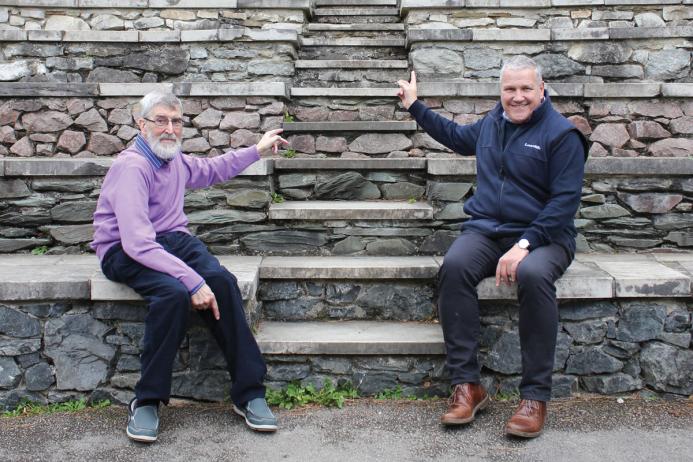
First published in the December 2021 issue of Quarry Management as Perfect Partners
The recent announcement of the proposed merger between the Institute of Quarrying (IQ) and the National Stone Centre (NSC) marks an exciting new chapter for both organizations. QM spoke to Viv Russell, IQ Chairman, and Ian Thomas, one of the original founders and directors of the NSC, about the long-term goals of the partnership and the development of a brand-new, state-of-the-art IQ headquarters in the Derbyshire Dales that will serve as an international ‘Centre of Excellence’ for the quarrying and mineral products industry
One of the most significant announcements in the quarrying and mineral extractives sector in 2021 was that of the planned coming together of the Institute of Quarrying (IQ) and National Stone Centre (NSC). Both longstanding organizations have a proud legacy of inspiring people through building knowledge, raising awareness, and supporting their respective industries in key areas such as education.
When the two organizations are working as a single entity, the partnership will represent a major leap forward in the way the IQ and NSC fulfil their missions and goals, the most important of which will be the development of a brand-new international Centre of Excellence for the quarrying, extractives, and stone-related industry.
The Institute is pulling out all the stops to ensure this landmark project is a huge success. The new development will involve transforming the existing space at the National Stone Centre site, just outside Wirksworth, in the Derbyshire Dales, to create a state-of-the-art, world-class visitor attraction. The Centre of Excellence will also become the new home of IQ, which is relocating from its current offices in Chilwell, Nottingham, after nine years of tenancy.
Views are currently being sought from a broad range of stakeholders to help formulate the full design plans and final evaluations for the new IQ headquarters and Centre, and it is hoped that these will be ready for public consultation in early 2022.
Viv Russell, Chair of the Institute of Quarrying, could not be happier to see these two forward-thinking, like-minded industry bodies joining forces to meet current and future challenges, whilst promoting the benefits of the minerals and stone industries. ‘Everyone at the IQ is delighted with our collaborative partnership with the NSC – as we share the same values, vision, drive and ethos in providing high-quality training and learning opportunities in this crucial sector for the whole country,’ he said.
‘The NSC is, of course, the brainchild of Ian Thomas, who has spent many years with a dedicated team of volunteers to ensure his visitor attraction/learning facility is a centre of excellence for geology. They’ve always been passionate about what they do and their drive and commitment to taking knowledge and teaching beyond the classroom – whether it is dry-stone walling, gem panning, fossil casting or geo-walks – is second to none.’
The new Centre of Excellence for IQ/NSC will be instrumental in bringing the two eminent industry bodies to work closely together and raise the profile of the quarrying and stone industries, their products, and the diverse career opportunities available.
A real asset
Opening the new purpose-built visitor centre will also present an exciting opportunity to support the Derbyshire economy, create local jobs, and help boost training and skills development across the area and beyond.
‘Derbyshire has a rich mining and quarrying heritage that has become a huge part of the region’s identity and economy,’ commented Mr Russell, ‘so it made perfect sense for IQ to relocate to the NSC and create a world-leading knowledge hub for the industry that will deliver wider benefits to the local economy and place the county firmly on the map.’
Echoing Mr Russell’s sentiments, Ian Thomas, one of the original founders and directors of the NSC, said the new flagship Centre will be an important landmark in both organizations’ evolution and provide a unique opportunity to highlight all that is great about Derbyshire, particularly its geological past and long history of quarrying and extraction activities.
‘I have absolutely no doubt that the Centre of Excellence will be a real asset to the High Peak and Dales,’ enthused Mr Thomas. ‘It will be a game-changing, state-of-the-art facility that will draw in visitors from far and wide and will be an incredibly important development for the whole of Derbyshire.’
As part of the partnership agreement, IQ will resource the new building with full-time management, as well as taking on the Centre’s administration and maintenance. All IQ staff will be relocating to the NSC and hope to be on site in early 2022.
Economic recovery
The mineral extractives and aggregates sector brings a significant financial benefit to Derbyshire; there are currently more than 20 active quarries across the Peak and Dales area, generating around £2.1 billion gross value added (GVA) per year to the national economy.
As one of the key employers in the region, future-proofing the quarrying sector’s workforce is not only an ongoing challenge, but also an imperative that is being addressed across the wider construction industry.
‘One of the major ambitions for the Centre of Excellence is to help tackle the alarming national skills shortage in the construction products sector,’ said Mr Russell. ‘A core focus for us will be engaging with and educating local groups and communities about the industry’s positive impact and the importance of minerals – both historically and into the future.
‘The National Stone Centre already attracts thousands of schoolchildren, visitors, and tourists a year, but the merger of the NSC with IQ will take things to the next level. The new Centre will be a fantastic addition to the region’s tourism offering as a unique and exciting, new ‘story-telling’ attraction for the quarrying and stone sectors.
‘Importantly, it will provide a springboard for Derbyshire’s economic recovery post Covid, attracting tens of thousands of visitors, creating new jobs, supporting local businesses, and making a positive impact on the regional economy.’
The Institute of Quarrying and NSC are deeply committed to working in close partnership with local communities, schools, colleges, interest groups, the supply chain, and other industry bodies, to ensure the new Centre of Excellence provides a positive presence and makes a real difference in terms of helping to educate, inspire and showcase the full range of innovative skills developed in the modern construction world.
‘It’s about building better relations with local communities and ‘giving something back’ to the public,’ said Ian Thomas. ‘Conducting public consultations to keep the surrounding community up to date and providing the opportunity for them to have their say are at the heart of the development process of the new Centre and most of our decision-making.
‘We’re managing those relationships and keeping people informed because this is a long-term project. In October this year, we held our first open public meeting to discuss plans for the Centre and to encourage feedback from local residents and the wider community.
‘And the general consensus amongst those who attended the event was that they were very keen that current facilities, such as the popular ‘Blue Lagoon’ coffee house & café, should remain open, along with our outdoor attractions that highlight Derbyshire’s prehistoric past.’
Inspiring futures in minerals
The creation of a new Centre of Excellence for mineral products in the heart of Derbyshire could not come at a better time, with there being an urgent need for fully qualified and skilled workers in the wider construction sector.
Once built, it will more than double the existing indoor space at the NSC with new facilities, including modern office workspace, boardrooms, seminar rooms, training workshops and various teaching spaces. Central areas of the building will host an immersive visitor/exhibition centre, cafe, flexible meeting rooms, student social spaces and an impressive open-plan reception area.
The design brief also includes new, state-of-the-art skills and simulation facilities which will use cutting-edge technologies – such as fully immersive virtual reality and mobile plant simulators – to revolutionize the way in which training and learning are delivered in quarrying and stonemasonry disciplines.
‘The IQ/NSC management board has made sure that the new building will meet all of our requirements going forward,’ said Mr Russell. ‘Whilst the new purpose-built offices and facilities will play a key role in shaping the IQ/NSC culture and maintaining the ethos of both organizations, the Centre also represents a major step forward towards securing the much-needed skills, professional development and competence for the future of our industry.
‘Our vision is for the Centre of Excellence to become a new home to an unrivalled source of innovation, knowledge, education and expertise for this important sector. It will play a fundamental role in connecting communities and inspiring current and future generations through a shared passion and enthusiasm for minerals and construction.’
The new IQ/NSC Centre will seek to use modern methods of construction, whereby structural components (eg walls, floor slabs, pillars, service risers, high-quality facades etc) will be fabricated off site in a factory-controlled environment before being transported to site for assembly, offering an innovative way of designing and constructing a quality building quickly, efficiently, safely, and to higher-quality standards and specifications. This methodology will also result in reduced environmental impact, such as less carbon/energy usage and less waste.
‘The design blueprint and pioneering off-site production approach fits absolutely perfectly with our environmental aspirations,’ said Mr Russell. ‘In a bid to make the building as environmentally friendly as possible, the Centre will incorporate green technologies and features, and provide a sustainable building design that demonstrates the Institute and NSC’s commitment to sustainability, natural resource management, the circular economy, and a carbon-neutral future.’
Shared vision
The investment in the new Centre of Excellence will no doubt help plug the construction/ quarrying skills gap and shortages for the wider industry, and both Viv Russell and Ian Thomas are proud to be part of a landmark building project that will help train and educate the next generation of professionals coming into the sector.
It is also exciting for IQ and NSC to be involved in a scheme that is helping to present a positive image of the mineral extractives sector and develop future leaders of the industry through greater diversity and inclusion, and clear and aspirational career pathways.
Once completed, the Centre will be a multifunctional complex housing a variety of key activities, ranging from study tours and careers fairs through to educational workshops and even a National Archives facility for the quarrying industry.
‘Community engagement is one of the Institute’s core values and has long been embedded across the mineral products and stone industries,’ said Mr Russell. ‘In establishing the new Centre of Excellence, we will continue to work in close collaboration with the local supply chain, employers, schools, colleges, public sector bodies, and partner organizations to encourage more young people to develop a lifelong relationship with quarrying from an early age and, hopefully, to consider a career in minerals extraction.’
He continued: ‘There is clearly a national skills shortage in the construction supply chain and one of the biggest challenges facing the industry is inspiring a new generation of children and young people to say: ‘I want a job in quarrying’. However, there is a perception barrier that we need to overcome. We must make a conscious effort to be more open and engaging, and present the many positives of our industry, which is fundamental to the future health of construction and the wider economy.’
Looking ahead, Mr Thomas is clearly excited by the growth opportunities for the Institute and NSC. The flagship Centre of Excellence will not only provide a perfect base for IQ/NSC to further develop and expand its Continuing Professional Development (CPD) courses for members and students, but also a stronger platform to give more people the opportunity to engage with the industry and show that minerals and quarrying are more relevant than ever in today’s society.
Mr Thomas concluded: ‘Making the mineral products, stone and extractives industries attractive to young people is a major challenge for us all, and the new Centre of Excellence will provide a unique opportunity to connect communities, drive positive social change, and inspire generations – both at a local level and on the international stage.
‘Young people have different expectations, and the Centre will be a great focal point for engaging members, local communities, schools and colleges in the science, history, present and future of the wider quarrying sector. Together, we need to ensure our industry is accessible, sustainable, and supports hard-to-reach communities. Both the IQ and the NSC are fully committed to this long-term vision, and the creation of the Centre of Excellence brings us one step closer toward making that vision a reality.’
Background to the National Stone Centre
The germ of the idea for a National Stone Centre (NSC) was put forward by Ian Thomas, a chartered geologist, freelance artist/designer and leading quarry historian, at an industrial archaeology conference in Coalville in 1978, and two years later a group in Matlock began to progress the concept. In the first instance, just under 100 sites in the north Midlands and south Pennines were examined against around 30 key criteria. The Coal Hills area comprising six disused quarries near Wirksworth came out well ahead of the field.
The entire 60-acre Coal Hills complex of holdings (Coal Hills Quarry, Steeple House Quarry, North East Quarry, West Quarry, South East Quarry and Reef Quarry) north and south of the old Cromford & High Peak Railway (now the High Peak Trail) was purchased from Tarmac in 1984 by Derbyshire County Council, with the benefit of a Department of the Environment 100% Derelict Land Reclamation Grant. At that point the site largely comprised barren tips and quarries, clad with just half a dozen trees. The intention was to support the development of the NSC and promote a small industrial park on an area of quarry and mine tips in the southernmost 10 acres. Work on the latter started in 1986 and by 2000 the industrial area was employing around 140 people.
In the interim, around half of the remaining 50 acres of the NSC had been designated a geological Site of Special Scientific Interest (SSSI), on account of its national significance as a unique Carboniferous carbonate reef complex (see end note). In Autumn 1988, a major reclamation scheme commenced on the main site, which involved making safe many of the 60 or so lead mine shafts on site, reshaping old tips, and sensitively transforming the area in readiness for the NSC. A large-scale tree-planting programme was also implemented at this time.
The existing Visitor Centre was built in 1989 and officially opened to the public in Spring 1990, with its permanent ‘Story of Stone’ exhibition and associated outdoor trails attracting hundreds of school groups and many other visitors from all over Britain each year ever since. In May 2000, with the assistance of Landfill Tax Credits from Tarmac, and a donation from RMC UK, the NSC purchased the freehold of the site from Derbyshire County Council.
A decade or so later the Council bought back a parcel of land to create the Derbyshire EcoCentre, which opened in 2010. Built at a cost of £1.43 million, the facility’s award-winning design was based on Pentre Ifan, a prehistoric site in Pembrokeshire. The Centre claims to be unique, operating as the county hub for adult education on sustainability. The County Council purchased the related land area in 2012.
A further area of NSC land was purchased in 2014 and developed into the £3 million Mount Cook Adventure Centre. This not-for-profit organization is dedicated to providing access to the outdoors, accommodation, and adventure activities for all.
Along with a major refurbishment of the NSC Visitor/Discovery Centre in 2016/17, all these developments form components in National Stone Centre’s long-term strategy to promote campus-style, multi-disciplinary, collaborative educational experiences, in partnership with others, engaging with both the historical and natural assets of the area, and with the broader network of the UK quarrying industry and academia.
A geologically unique site
Evidence in the rocks indicates that 330 million years ago the NSC site sat precisely on the boundary of a very shallow sea area (occasionally emerging as land – the East Midlands Platform) to the north, and a deeper-water regime (the Widmerpool Gulf) to the south. The regular horizontal bedding seen north of the High Peak Trail and in North East Quarry is indicative of the shallow waters which ranged northwards to Buxton and Castleton. The remaining quarries south of the Trail, most notably Reef Quarry, display fringing fossil mounds which formed a protective barrier against the stormy deeper water conditions which produced mudstones underlying the valley to the south. The ancient environment was comparable to the present-day Caribbean, and the NSC exposures are unique in that they represent the best examples of their kind in the UK within such a compact area.
- Subscribe to Quarry Management, the monthly journal for the mineral products industry, to read articles before they appear on Agg-Net.com



